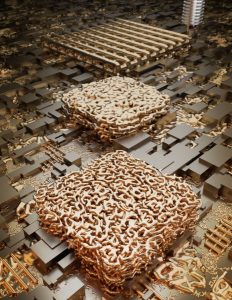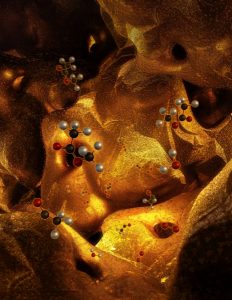Lawrence Livermore National Laboratory (LLNL) is known for doing impressive work with materials, particularly related to 3D printing. Whether it’s nanoscale 3D printing or 3D printed glass, the organization is constantly making new discoveries. In its latest study, entitled “Toward digitally controlled catalyst architectures: Hierarchical nanoporous gold via 3D printing,” LLNL researchers along with those from Harvard University discuss the hierarchical printing of nanoporous gold. According to the researchers, this work could have a major impact on the design of chemical reactors.
Nanoporous metals are strong catalysts for chemical reactions, as they have a large surface area and high electrical conductivity. This makes them well-suited to applications such as electrochemical reactors, sensors and actuators.
“If you consider traditional machining processes, it’s time consuming and you waste a lot of materials — also, you don’t have the capability to create complex structures,” said LLNL postdoctoral researcher Zhen Qi, a co-author on the paper. “By using 3D printing we can realize macroporous structures with application-specific flow patterns. By creating hierarchical structures, we provide pathways for fast mass transport to take full advantage of the large surface area of nanoporous materials. It’s also a way to save materials, especially precious metals.”
The researchers combined an extrusion-based direct ink writing process with an alloying and dealloying process to engineer nanoporous gold into three distinct scales, from the microscale to the nanoscale. According to the team, the hierarchical structure “dramatically improves mass transport and reaction rates for both liquid and gases.” Being able to manipulate the catalyst’s surface area to generate electrochemical reactions through 3D printing could have a big impact on electrochemical plants, which currently rely mostly on thermal energy.
“By controlling the multiscale morphology and surface area of 3D porous materials, you can start to manipulate the mass transport properties of these materials,” said LLNL researcher Eric Duoss. “With hierarchal structures you have channels that can handle transfer of reactants and products for different reactions. It’s like transportation systems, where you go from seven-lane expressways down to multiple lane highways to thoroughfares and side streets, but instead of transporting vehicles we’re transporting molecules.”
LLNL researcher Cheng Zhu and former postdoctoral student Wen Chen made inks out of gold and silver nanoparticles, which were then 3D printed. The printed parts were placed into a furnace to allow the particles to coalesce into a gold-silver alloy. The team then put the parts into a chemical bath that removed the silver in a process called dealloying, leaving porous gold behind.
“The final part is a 3D hierarchical gold architecture comprising the macroscale printed pores and the nanoscale pores that result from dealloying,” said Chen, who is currently a professor at the University of Massachusetts-Amherst. “Such hierarchical 3D architectures allow us to digitally control the morphology of the macropores, which allowed us to realize the desired rapid mass transport behavior.”
According to Zhu and Chen, the method can also be applied to other metals such as magnesium, nickel and copper, opening up 3D printing applications in fields such as catalysis, batteries, supercapacitors and carbon dioxide reduction.
The challenge in catalysis, according to LLNL researcher Juergen Biener, is in combining high surface area with rapid transport.
“While additive manufacturing is an ideal tool to create complex macroscale structures, it remains extremely difficult to directly introduce the nanostructures that provide the required high surface area,” Biener said. “We overcame this challenge by developing a metallic ink-based approach that allowed us to introduce nanoporosity through a selective corrosion process called dealloying.”
Biener said that the team’s extrusion-based approach is universal and scalable, provides tooling-free control over the macroscopic sample shape, and enables integration of nanoporosity in an application-specific engineered macroporous network structure. These advantages open new design possibilities for chemical reactor and energy storage and conversion devices.
The project is part of a feasibility study into a proposed strategic initiative to create 3D electrochemical reactors in which scientists could have greater control over catalysts and reduce transport limitations. Instead of large electrochemical plants, which are located near oil refineries or in remote areas, modular reactor networks could be created in a series that could be easily replaceable and transportable to locations near sources of abundant renewable energy or carbon dioxide.
“There are a whole lot of scientific and engineering challenges left, but it could have significant impact,” said Chris Spadaccini, director of LLNL’s Center for Engineered Materials and Manufacturing. “Scaling up should be easier with small-scale reactors because you can parallelize. You could have an array of small 3D reactors together instead of one large vessel enabling you to control the chemical reaction process more effectively.”
The researchers are also starting to explore other materials that could be catalysts for other reactions.
Authors of the paper include Cheng Zhu, Zhen Qi, Victor A. Beck, Mathilde Luneau, Judith Lattimer, Wen Chen, Marcus A. Worsley, Jianchao Ye, Eric B. Duoss, Christopher M. Spadaccini, Cynthia M. Friend and Juergen Biener.
Discuss this and other 3D printing topics at 3DPrintBoard.com or share your thoughts below.
[Source: Newswise]




52 Replies to “Lawrence Livermore National Laboratory Makes 3D Printed Nanoporous Gold That Could Change the Design of Electrochemical Reactors”
Comments are closed.